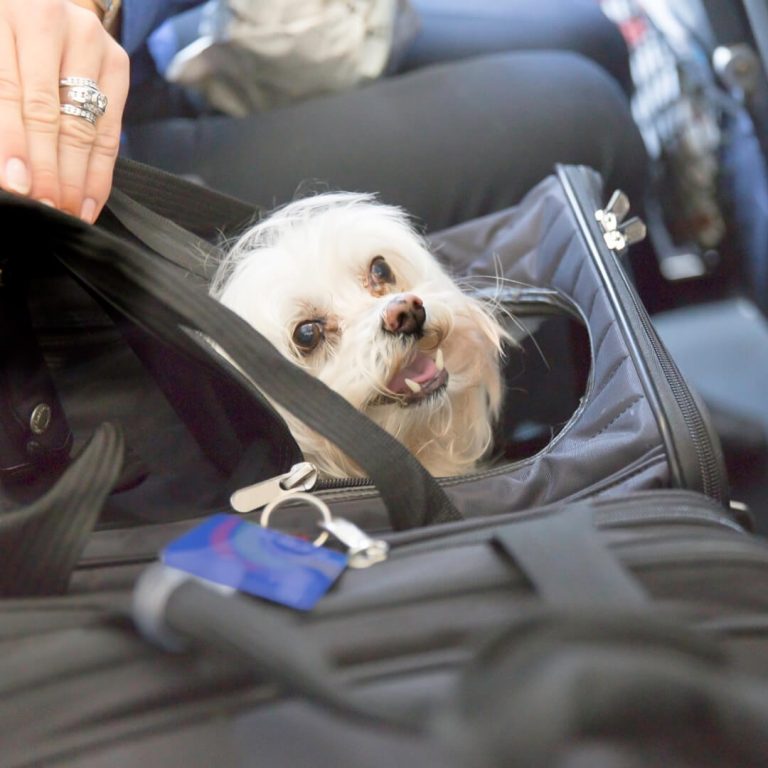To travel with your pet or not to travel with them. Many people struggle with this all-important question before summer vacations, holiday trips and weekend getaways. Pets are such beloved family members, but traveling with them presents challenges. Here’s a look at your options so you can make the best choice for you and your pet the next time you hit the open road or fly the friendly skies.
Should you bring your pet on vacation?
Before you decide to pack a bag for a furry traveling companion, there are three major things to consider:
- Your pet’s preference and health
Before your trip, put yourself in your pet’s paws. If you know that they’re comfortable around new people and places, remain calm in big crowds, don’t get upset in a carrying crate and aren’t scared by loud noises, then travel likely won’t faze them. If you have a new puppy or kitten that you’re still getting acquainted with, ask your veterinarian if they’re ready for travel.Speaking of the vet, make sure your pet is healthy enough for travel by scheduling a check-up and making sure their shots are all up to date. - Your destination and mode of transportationIf you’ve booked a leisurely vacation, such as a beach trip, then your pet can happily relax by your side the whole time. However, an itinerary-scheduled day and night with non-pet friendly sightseeing tours and activities might be fun for you, but not so much for the animal left at your hotel or rental. Next, take traveling distance into account. It typically determines how you’re getting to your destination. Most experts agree road travel is the easiest on animals, but while you’re driving, they recommend making frequent stops and putting your pet in a crate that’s secured inside your vehicle.
Flying can be more difficult. Although you can bring smaller pets onboard with you, bigger breeds fly in the cargo hold, which can cause anxiety for you and your pet. Air travel can even be dangerous for dog breeds with “pushed in” faces, such as Bulldogs and Boxers. Their facial structure makes it hard to breathe at high altitudes, especially in the cargo area where there’s no climate control.
Some airlines offer a special pet compartment for first-class-ticketed passengers that provides closer access to your animal in flight and a more luxurious ride for the two of you. However, this isn’t available on every route or aircraft and there are some size and age restrictions, plus a limited number of compartments per plane. Call the airline to see if this is an option for the flight you want to book.
If you choose to fly with your pet, take these precautions:
- Book early and review the airline’s pet policies
- Prepare to pay the pet fee, typically around $100 to $125 for either first- or economy-class
- Choose a direct flight
- Use an airline-approved carrier labeled with your pet’s name and your contact information
Traveling by train is another possibility if you have a small dog or cat, which are allowed on Amtrak routes under seven hours for $26. Only five non-service animals are permitted on each train, so buy your ticket and review Amtrak’s pet policies in advance to avoid problems on the day of travel.
- Your accommodationsNot all hotels welcome pets. If you want to bring them with you, do your homework. Frommer’s points out that even pet friendly ones can present challenges, such as:
- Weight limits
- Pet fees and/or pet deposits, typically $50 to $100 per stay
- Not allowing pets to be left alone in your hotel room
With vacation rentals, don’t rely on the description. Phone or email the owner or property manager to confirm they allows pets. Typically, the short supply of pet-friendly accommodations gets snatched up quickly by other dog and cat lovers, so reserve your stay as soon as you decide to travel.
Should you keep your pet at home?
As hard as it is to leave your pet behind, sometimes it’s for the best. In that case, your biggest dilemma is deciding on a caretaker.
The most convenient and, likely, cheapest option is to get a trusted family friend or neighbor to watch your pet, either in your home or theirs. As an enticement, offer to watch their pet the next time they go out of town. Your neighborhood Facebook or Nextdoor page might also list pet sitters who live nearby.
Some pet owners prefer to use a professional pet-care service with vetted sitters, either a local business or a nationwide firm, such as Fetch, PetSitter or Rover. You can compare sitters based on price, experience and availability before choosing one who boards pets in their home or comes to yours.
Whether you hire a pet-sitter through a service or on your own, the price will depend on the type of care you want and the size and breed of your pet. For example, to just have a sitter drop by to feed and walk your dog you can expect to pay anywhere from $10 to $25 per visit. For 24/7 care in your home or the sitter’s, the typical price ranges from $50 to $100, or more for a highly experienced or in-demand caretaker.
Many veterinarians also board animals as do traditional kennels and catteries, which charge overnight rates that range between $25 and $55. Before you choose this route, tour the place to see how pets are housed and treated and ask if they receive personal attention from staff.
When it comes to canines, you can really pamper them while you’re traveling by putting them up in a luxury dog hotel, where they enjoy their own private room often equipped with a TV and webcam. This will cost you about $75 to $95 per night.
Final thoughts: does Fluffy travel or stay home?
No matter what you decide, your animal will likely encounter unfamiliar people or environments while you’re away. You can ease their discomfort by making sure their favorite toy, usual food, daily medication, vet contact information and health and immunization records always stay with your pet.
Editor’s note: Quorum derives no benefit from businesses for placement in this article.






Whatever you choose, your pet will probably come into contact with strange people or surroundings while you’re away. By ensuring that your pet always has access to their favorite toy, regular food like available at PetCareRx, daily medications, vet contact information, and health and immunization records, you can lessen their discomfort.